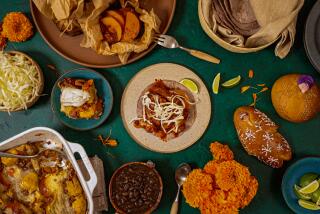Morelia’s study in beauty
- Share via
MORELIA, MEXICO — Inow know what it feels like to be inside a snow globe.
But instead of fake, swirling white snowflakes, substitute butterflies -- hundreds, thousands, millions of orange-and-black monarchs -- flying around like autumn leaves in a gale. Then, you can envision the scene at the Santuario de la Mariposa Monarca (Monarch Butterfly Sanctuary) near Morelia.
Each fall, 150 million of the butterflies set off from the northern United States for the highlands east of Morelia. They take on this annual migration -- about 2,500 miles -- to winter where the oyamel fir trees grow. From November through March, they gather to mate and feed on the nectar of local flowers.
Last winter, I began to envy the monarchs, which each year leave the cold and gloom for warmth and sunshine. How nice it would be to huddle together in the morning air of a mountaintop, then enjoy the midday sun in a forested preserve under an innocent blue sky.
So, in January, I flew to Mexico City with my wife, Janice, and our son, Paul, then took a comfortable but inexpensive bus west to Morelia, the capital of the Mexican state of Michoacan. We spent 10 days in Michoacan, which lies between Mexico City and the Pacific.
Morelia, which has more than half a million residents, was named Valladolid just after its founding in 1541, but it was renamed in 1828 in honor of Jose Maria Morelos, a local leader in Mexico’s fight for independence from Spain. The Spanish influence remains, however, in Morelia’s architecture.
UNESCO designated it a World Heritage Site in 1991, because more than 200 colonial-era buildings still stand in the city’s center. Among them: a long stone aqueduct, which provides a series of graceful arches for games of hide-and-seek, and an 18th century fountain where three statues of women hold cornucopias of food.
Our mornings typically began with breakfast at one of the sidewalk cafes facing the zocalo, or town square. Cafe con leche (coffee with milk) -- so milky that it really should be called leche con cafe (milk with coffee) -- was followed by many happy combinations of eggs and peppers. My favorite was two fried eggs, one with red salsa, one with green. It looked like a spicy traffic light on a tortilla.
The cafes gave us diners a nice view of the pretty tower of San Agustin, an old monastery church across the square. Bells at the Cathedral of the Divine Savior rang as the world passed by our table.
The 18th century cathedral, whose exterior is pink, starts off simply, its lower level built of unadorned blocks. Then it gets Baroque, with balconies and niches for statues and pigeons, crowned with two 200-foot bell towers.
In contrast to its exterior, the cathedral’s interior is sedate, its grays and browns reminding me of the parlor of a devout, wealthy grandmother.
The morning Janice and I toured the cathedral, it was busy, even during a weekday hour when Mass was not being said. Cleaning men polished gold trim and dusted statues of the saints. A woman trimmed chrysanthemums behind the altar, creating floral confetti. A little girl dipped her fingers in the holy water font and, unafraid of offending the pious, giggled. Two praying, middle-aged women advanced slowly on their knees down the center aisle toward the altar. A line of women waited for their turns in the open confessional.
Appropriately, I had an almost holy experience with a shoeshine on the sidewalk adjacent to the cathedral. The shoeshine man, exceedingly polite and neatly groomed, crossed himself as I hopped into his raised chair. The ensuing shine was the most thorough I’ve ever had; when I left, my ratty old shoes gleamed and my feet felt as though they had been massaged. I went back to him the next day, even though my shoes didn’t need another shine.
UNIVERSITY TOWN
Because Morelia is a university town, tourists can benefit from businesses that cater to students’ needs -- maybe not shoeshines, but Internet cafes, laundromats, varied night life, inexpensive food and transportation.
The library at the University of Michoacan de San Nicolas de Hidalgo has three 10-foot levels of shelves sagging under the weight of ancient-looking volumes. The room smells deliciously booky.
A large, modern mural at one end shows likenesses of Albert Einstein and other representatives of scholarly fields. An academic building on the same street is designed so that each classroom opens onto a large central courtyard. Its stairwells are decorated with murals reflecting fierce patriotism and reverence for Mexico’s freedom fighters.
Students often eat on the go, so I was not surprised that good tacos, gorditas and other fast food were plentiful. My favorite discovery was gaspacho, a sort of juice, sort of salad. The Morelian version consists of chopped pineapple and jicama, crumbled cheese, two kinds of peppers, salt, and lime and orange juice. You use a straw for the juice and a spoon for the crunchy remainder.
I found two other standouts. At Meson Agustinos, a cafe near the zocalo, we sampled hot chocolate in a variety of strengths and sweetnesses. We settled on amargo, an intense chocolate, with milk. It was like drinking a fudge brownie.
At Los Mirasoles, a restaurant that specializes in regional cuisine, we tried ixtabentun, a Mexican liqueur flavored with anise and honey, so penetratingly aromatic that I repeatedly set down the snifter, lest its vapor fill my brain and turn me into an anise-scented bee.
There were real honeybees buzzing in the candy market (el mercado de dulce) up the street from the zocalo. A large covered market, it supplements craft items and predictable tourist pieces with candy. We saw and tasted citrus con coco (candied whole lime peel stuffed with sweetened coconut), birds nests of coarse-grated coconut and caramel, and brittles (peanut, sesame seed, pumpkin seed).
We were here for more than just the cuisine, however. The monarchs spend their winters in only a dozen or so spots in Mexico, and many are accessible from Morelia. We hired a guide and made the two-hour journey by van to the Santuario de la Mariposa Monarca, which is up about 10,000 feet.
The road plays out near the peak, and Janice and I did the last mile on horseback. At first, I rejected the horse, determined to hike with Paul. After about 50 yards in the oxygen-thin air, however, I croaked out, “Horse!” and abandoned plans for father-son bonding.
As we neared the summit, the butterfly situation looked disappointing. Only a few stray monarchs clung lethargically to the trees. But the farther we went, the more we saw, swirling in the air, alighting on fir branches. Soon, they were as thick as swarming bees and seemed to be flying in formation. But they were silent; we could hear only a soft wind caressing the evergreens.
And my own exclamations of frustration. Photographing butterflies in flight is difficult, particularly if, like me, you depend on the idiot-proof camera settings. What you get are perfectly focused shots of the sky with butterfly-colored blurs in the foreground. (Photography probably would be easier on cool mornings, when the sleepy butterflies envelop the trees, seeming to transform firs into maples.)
Their lives are as fleeting as the twirls of a snow globe’s flakes. The monarchs migrate to Michoacan to reproduce. Males die after mating; females return to the States to lay their eggs, then die too.
Their life spans are made even more precarious by predatory birds and bad weather -- freezing rain can kill them off by the millions -- and illegal logging in their oyamel fir tree habitat.
Because no monarchs live long enough to make a repeat trip, they can’t rely on memory to tell them how to get to Michoacan. How they navigate is one of those mysteries that make the natural world so satisfying. As I stood on the forested hilltop, it occurred to me that they might have similar questions about us.
That evening, we returned to Morelia in time for sunset and some grazing among the street-side vendors. A lively band at the cathedral side of the zocalo played as the trees on the square became silhouettes, then shadows.
How nice to be a student here, I mused. Or an American visitor. Or a butterfly.
--
(BEGIN TEXT OF INFOBOX)
Planning this trip
THE BEST WAY
From LAX, Mexicana has nonstop service to Morelia; Continental has connecting service (change of plane). Restricted round-trip fares begin at $378.
TELEPHONES
To call the numbers below from the U.S., dial 011 (the international dialing code), 52 (country code for Mexico), 443 (city for Morelia) and the local number.
WHERE TO STAY
The hotels listed below are near the zocalo and cathedral.
Hotel Virrey de Mendoza, 310 Avenue Madero Puente; 312-06-33, www.hotelvirrey.com. Luxury hotel at edge of zocalo radiates classiness. Doubles from $175. Seasonal butterfly packages from $415 include two nights’ lodging, and city and sanctuary tours.
Hotel Catedral, 37 Zaragoza; 313-04-06, www.hotelcatedralmorelia.com. Clean and comfy. Doubles from $92.
WHERE TO EAT
Los Mirasoles, 549 Madero Puente; 317-57-75. Moderate prices for regional dishes emphasizing peppers, trout and savory sauces. Entrees around $15.
Plaza San Agustin, the home of several vendors of a variety of antojitas (snacks) cooked in front of you, most of them deep-fried. Late afternoon and into the night; expect to pay less than $5 to stuff yourself.
Comida Casera Maru, 610 Calle la Corregidora. Tiny place on the western end of the central district has wonderful soups and latke-like potato cakes. Typical lunch with homemade pineapple drink about $4.
WHAT TO DO
Butterfly peeping: Tours of the sanctuaries can be arranged through your hotel staff or the local tourist office (near the university and candy market). We paid about $50 each, including tips. Use of a horse (recommended unless you’re in great physical shape) added about $10 each.
TO LEARN MORE
Michoacan Tourism Office, www.michoacan-travel.com.
Mexico Tourism Board, (800) 446-3942, www.visitmexico.com.
--
On travel.latimes.com
For more views of Morelia and surrounding areas, go to latimes.com/morelia.
More to Read
Sign up for The Wild
We’ll help you find the best places to hike, bike and run, as well as the perfect silent spots for meditation and yoga.
You may occasionally receive promotional content from the Los Angeles Times.






